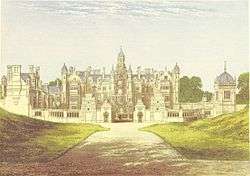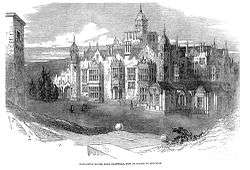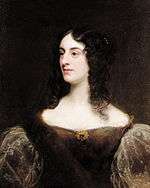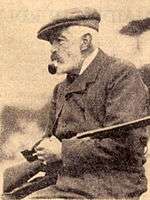Harlaxton Manor
Harlaxton Manor, built in 1837, is a manor house located in Harlaxton, Lincolnshire, England. Its architecture, which combines elements of Jacobean and Elizabethan styles with symmetrical Baroque massing, renders the mansion unique among surviving Jacobethan manors.
| Harlaxton Manor | |
|---|---|
 | |
| Type | House |
| Location | Harlaxton |
| Coordinates | 52.8806°N 0.671°W |
| Governing body | University of Evansville |
National Register of Historic Parks and Gardens | |
| Official name: Harlaxton Manor park and garden | |
| Designated | 24 June 1985 |
| Reference no. | 1000982 |
Listed Building – Grade I | |
| Official name: Harlaxton Manor | |
| Designated | 19 February 1952 |
| Reference no. | 1298440 |
Listed Building – Grade I | |
| Official name: Forecourt gateway and screen | |
| Designated | 19 February 1952 |
| Reference no. | 1236557 |
Listed Building – Grade II* | |
| Official name: Harlaxton Manor bridge | |
| Designated | 24 September 1979 |
| Reference no. | 1187968 |
Listed Building – Grade II* | |
| Official name: Harlaxton Manor Gatehouse | |
| Designated | 24 September 1979 |
| Reference no. | 1236606 |
 Location of Harlaxton Manor in Lincolnshire | |
The manor currently serves as the British campus for the University of Evansville and partners with Eastern Illinois University and Western Kentucky University.
Harlaxton Manor is listed Grade I on the National Heritage List for England, as is its forecourt gateway and screen. The surrounding park and gardens are listed Grade II* on the Register of Historic Parks and Gardens.[1][2][3]
History

Harlaxton is first recorded in the Domesday Book as Harleston.
The current mansion is the second Harlaxton Manor. The first was built on a different site during the 14th century and was used as a hunting lodge by John of Gaunt. By 1619, Sir Daniel de Ligne purchased the manor.[4] The original house was deserted after 1780; it was inherited by Gregory Gregory, and was torn down in 1857.
The current house was built by Gregory from 1837 to 1845 and helped usher in a renaissance of Elizabethan architecture. The original architect, Anthony Salvin, was replaced by William Burn, who is responsible for its interior detailing. Upon Gregory's death, the manor passed to his cousin George Gregory and then in 1860 to a distant relative, John Sherwin-Gregory. Upon the death of Sherwin's wife in 1892, it passed to his godson Thomas Pearson-Gregory, who allowed it to fall into disrepair.
The manor passed through several sets of disparate hands in the twentieth century. Abandoned by 1935, it was purchased two years later by Violet Van der Elst, a businesswoman and inventor, who made her money from developing the first brushless shaving cream and made her name by campaigning against capital punishment. She restored the house and had it wired for electricity. During the Second World War it was requisitioned by the Royal Air Force as the officers' mess for RAF Harlaxton and later to house a company of the 1st Airborne Division. In 1948, Harlaxton was purchased by The Society of Jesus, who used it as a novitiate. They in turn sold the manor, while retaining rights to some of the lands, to Stanford University in 1965. The University of Evansville began using the property in 1971 as its British campus, but it was owned by William Ridgway, a trustee of the university, until 1986. Immediately after the purchase, the University of Evansville began renovating the entire facility.
Present day
Harlaxton is currently owned by The University of Evansville operating as Harlaxton College and hosts their study abroad programme. Since 1984, Harlaxton Manor has also been the site of the annual Harlaxton Medieval Symposium, an interdisciplinary symposium on medieval art, literature, and architecture.[5] It also serves as a study abroad university for English majors from Eastern Illinois University, Honors College students from Western Kentucky University, students at the Carol Martin Gatton Academy of Mathematics and Science in Kentucky, students from Baker University in Kansas, and honours program students from Hannibal-LaGrange University.[6]
The Gregory family

Gregory Gregory (1786–1854) was born Gregory Williams and only adopted the surname Gregory when he inherited his uncle’s estates. His father was William Gregory Williams (1742–1814) who owned Rempstone Hall in Leicestershire. His mother was Olivia Preston (1758–1835). In 1822 Gregory inherited Harlaxton Manor and other property from his uncle George de Ligne Gregory (1740–1822).[7] At this stage Harlaxton Manor was an ancient building in need of repair so Gregory did not move to the house. Instead he lived at the nearby Hungerton Hall. It seems that from this time he resolved to build a new manor at Harlaxton and to include within it many treasures which he intended to collect from all parts of the world. He was unmarried and remained a bachelor all his life so he was not impeded in this desire. In 1831 he commissioned the architect Anthony Salvin to build his mansion, a process which took 20 years.
In his diary of 1838 Hon. Charles Greville who visited the house while it was being built wrote.
- "To-day we went to see the house Mr. Gregory is building, five miles from here. He is a gentleman who has a fancy to build a magnificent house in the Elizabethan style, and he is now in the middle of his work, all the shell being finished except one wing. Nothing can be more perfect than it is, both as to the architecture and the ornaments.
- Many years ago, when he first conceived this design he began to amass money and lived for no other object. He travelled into all parts of Europe collecting objects of curiosity, useful or ornamental, for his projected palace, and he did not begin to build until he had accumulated money enough to complete his design. The grandeur of it is such, and such the tardiness of its progress, that it is about as much as he will do to live till its completion.
- It is the means and not the end to which he looks for gratification. He says that it is his amusement, as hunting or shooting or feasting may be the objects of other people and as the pursuit leads him into all parts of the world, and to mix with every variety of nation and character, besides engendering tastes."[8]
In 1843 the Illustrated London News published a drawing of the partially completed house which is shown.[9] By 1851 Gregory had moved into the new Harlaxton Manor as the Census of this time shows that he is there as the sole resident with fourteen servants. There was a butler, a house keeper, three footmen, seven domestic maids and two grooms. In 1854 Gregory died and the house was inherited by his cousin George Gregory.

George Gregory (1775–1860) was born in 1775 in London. His father was Daniel Gregory (1747–1819) who was a partner in the merchant firm Burton Forbes and Gregory. George did not follow his father’s occupation as a merchant instead he became the owner of an estate called Sprotlands in Willesborough. In 1825 at the age of 50 he married Elizabeth Price[10] who was twenty years his junior but the couple appear to have had no children. They moved to Harlaxton Manor after he received his inheritance as the 1855 Post Office Directory of Lincolnshire shows that he is in residence at that time.[11]
With other owners of large house in the area George decided to open the house to visitors. The advertisement for this is shown. The editor of the Grantham Journal attended one of these open days and described the house in detail in two articles.[12] This description gives a valuable insight into the inclusions of the house at this time. George died in 1860 at the Manor and a distant relative John Sherwin Gregory inherited the house.


John Sherwin Gregory (1803–1869) was born John Sherwin Longden. His father was John Longden and his mother was Charlotte Mettam. His father had inherited Bramcote Manor from his uncle who was from the Sherwin family.[13] He built a new house called Bramcote Hills House. When his father died in 1818 John inherited the Bramcote property and changed his surname to Sherwin thus becoming John Sherwin Sherwin. In 1829 he married Catherine Holden, daughter of Robert Holden[14] of Nuthall Temple which was a large house in Nottinghamshire. The couple lived at Bramcote Hills House[15] until John inherited Harlaxton Manor in 1860. The 1851 Census describes John as a "landed proprietor". When he inherited the property he changed his surname to Gregory thus becoming John Sherwin Gregory. Portraits of John and Catherine by the famous painter Thomas Phillips are shown.[16]


John died in 1869 and Catherine continued to live at Harlaxton Manor until her death in 1892 at the age of 86. In her obituary it was stated that "to the parishioners of Harlaxton Mrs Sherwin-Gregory was a kind and considerate friend and amongst her tenants she was held in high esteem. The poor always found in her a generous benefactor the deceased lady evincing a special interest in any who were sick."[17]
When she died in 1892 Thomas Sherwin Pearson who was the second cousin and godson of John Sherwin Gregory inherited the Manor.[18] Thomas added Gregory to his surname and so became Thomas Sherwin Pearson Gregory (1851–1935).
Thomas was born in 1851 in Barwell Leicestershire. His father was General Thomas Hooke Pearson and his mother was Francis Elizabeth Ashby Mettam.[19] Thomas’s grandfather Rev George Metttam was the brother of John Sherwin Gregory's mother Charlotte Mettam (see above) and therefore he was John's second cousin.
Thomas was educated at Rugby and Oxford University and became a first grade cricketer.[20] In 1885 he married Mabel Laura Payne who was the daughter of Sir Salusbury Gillies Payne. Unfortunately she died in childbirth three years later in 1888. In 1892 Thomas inherited Harlaxton Manor and moved there with his son Philip. When Philip went to Eton he lived there with a large number of servants including a valet.[21] He became involved in local affairs and was Chairman of Grantham Rural District Council. His obituary said that "he was keenly interested in angling and shooting and in the latter was considered one of the best shots in England of his time."[22] A picture of him smoking a pipe with one of his shotguns is shown.
He died in 1935 and his son Philip John Sherwin Pearson-Gregory (1888–1955) inherited the Manor. Philip decided not to live in the house and sold it in 1937 to Violet Van der Elst.
Listed buildings
To the north west of Harlaxton Manor, the bridge 800 metres from the house is listed Grade II*, as is the gatehouse 400 metres away and its attached boundary walls.[23][24] The kitchen's garden walls and the gardener's house 500 metres to the north west are listed Grade II* and the stables 70 metres from the house with their adjoining screen wall are listed Grade II.[25][26] The gateway and screen wall 1,200 metres north west of the manor are listed Grade II.[27]
The walls, steps, and gazebos to the south west of forecourt are listed Grade I.[28] The statue at the head of the ornamental garden steps 50 metres south west of the manor and the twelve stone benches in garden to south west of forecourt are both listed Grade II.[29][30] The ornamental garden steps 50 metres south west of the manor are listed Grade II*.[31]
To the south of Harlaxton Manor, the garden loggia and the loggia's steps and trough 90 metres to the south of the house are listed Grade II.[32][33] The gazebo 80 metres south of the manor is listed Grade II*.[34] The steps to the east and the west of the gazebo 80 metres south of the manor are listed Grade II.[35][36] The Baroque terrace fountain and statues 25 metres south east of the manor are listed Grade II*.[37]
Media appearances
The manor is a popular location for filming. Exterior and interior shots have been featured in the films The Ruling Class, The Last Days of Patton, The Lady and the Highwayman, The Haunting and The Young Visiters. More recently, the building was used as a site in the reality television series Australian Princess. In 2017 it appeared in Series 2 of Victoria as the Château d'Eu in Normandy, the country seat of Louis-Philippe I.
References
- Historic England, "Harlaxton Manor (1298440)", National Heritage List for England, retrieved 7 January 2016
- Historic England, "Forecourt gateway and screen at Harlaxton Manor (1236557)", National Heritage List for England, retrieved 7 January 2016
- Historic England, "Harlaxton Manor (garden) (1000982)", National Heritage List for England, retrieved 2 December 2016
- Lincolnshire Archives Committee (24 March 1960 – 20 March 1961). Archivists' Report 12. 1 Pearson-Gregory
- The Harlaxton Medieval Symposium
- http://www.hlg.edu/academics/honors.php
- Harlaxton Manor Archives "Gregory Gregory". Online reference
- Greville, Charles 1896 "The Greville memoirs : a journal of the reigns of King George IV, King William IV, and Queen Victoria", p. 44. Online reference
- Illustrated London News, 7 May 1843, p. 357. Online reference
- Nicholl John 1866 "Some Account of the Worshipful Company of Ironmongers", p. 597. Online reference
- POST OFFICE DIRECTORY OF LINCOLNSHIRE, 1855, p. 112. Online reference
- Grantham Journal – Saturday 28 May 1859, p. 3 and Grantham Journal – Saturday 04 June 1859, p. 2.
- Crisp Graham 2012 "Bramcote"p. 7. Online reference
- Walford, Edward "The County Families of the United Kingdom" p. 431. Online reference
- Bramcote History Group website. Online reference
- Sothebys website. Online reference
- Grantham Journal– Saturday 18 June 1892, p. 4.
- The National Archives website. Online reference
- Jackson, H. J. 1902 "Visitation of England and Wales", p. 75. Online reference
- Cricinfo website "Thomas Pearson". Online reference
- England Census of 1901.
- Grantham Journal – Saturday 30 November 1935, p. 10.
- Historic England, "Bridge 800 metres north west of Harlaxton Manor (1187968)", National Heritage List for England, retrieved 7 January 2016
- Historic England, "Gatehouse 400 metres north west of Harlaxton Manor and attached boundary walls (1236606)", National Heritage List for England, retrieved 7 January 2016
- Historic England, "Kitchen garden walls and gardeners house 500 metres north west of Harlaxton Manor (1298389)", National Heritage List for England, retrieved 7 January 2016
- Historic England, "Former stables 70 metres north west of Harlaxton Manor and adjoining screen wall (1298441)", National Heritage List for England, retrieved 7 January 2016
- Historic England, "Gateway and screen wall 1200 metres north west of Harlaxton Manor (1298442)", National Heritage List for England, retrieved 7 January 2016
- Historic England, "Walls steps and gazebos to south west of forecourt at Harlaxton Manor (1187969)", National Heritage List for England, retrieved 7 January 2016
- Historic England, "Statue at head of ornamental garden steps 50 metres south west of Harlaxton Manor (1194948)", National Heritage List for England, retrieved 7 January 2016
- Historic England, "Twelve stone benches in garden to south west of forecourt of Harlaxton Manor (1236577)", National Heritage List for England, retrieved 7 January 2016
- Historic England, "Ornamental garden steps 50 metres south west of Harlaxton Manor (1236717)", National Heritage List for England, retrieved 7 January 2016
- Historic England, "Garden loggia steps and trough 90 metres south of Harlaxton Manor (1187970)", National Heritage List for England, retrieved 7 January 2016
- Historic England, "Garden loggia 90 metres south of Harlaxton Manor (1264520)", National Heritage List for England, retrieved 7 January 2016
- Historic England, "Gazebo 80 metres south of Harlaxton Manor (1298388)", National Heritage List for England, retrieved 7 January 2016
- Historic England, "Steps east of gazebo 80 metres south of Harlaxton Manor (1194946)", National Heritage List for England, retrieved 7 January 2016
- Historic England, "Steps to west of gazebo 80 metres south of Harlaxton Manor (1194947)", National Heritage List for England, retrieved 7 January 2016
- Historic England, "Baroque terrace fountain and statues 25 metres south east of Harlaxton Manor (1236526)", National Heritage List for England, retrieved 7 January 2016
External links
| Wikimedia Commons has media related to Harlaxton Manor. |
